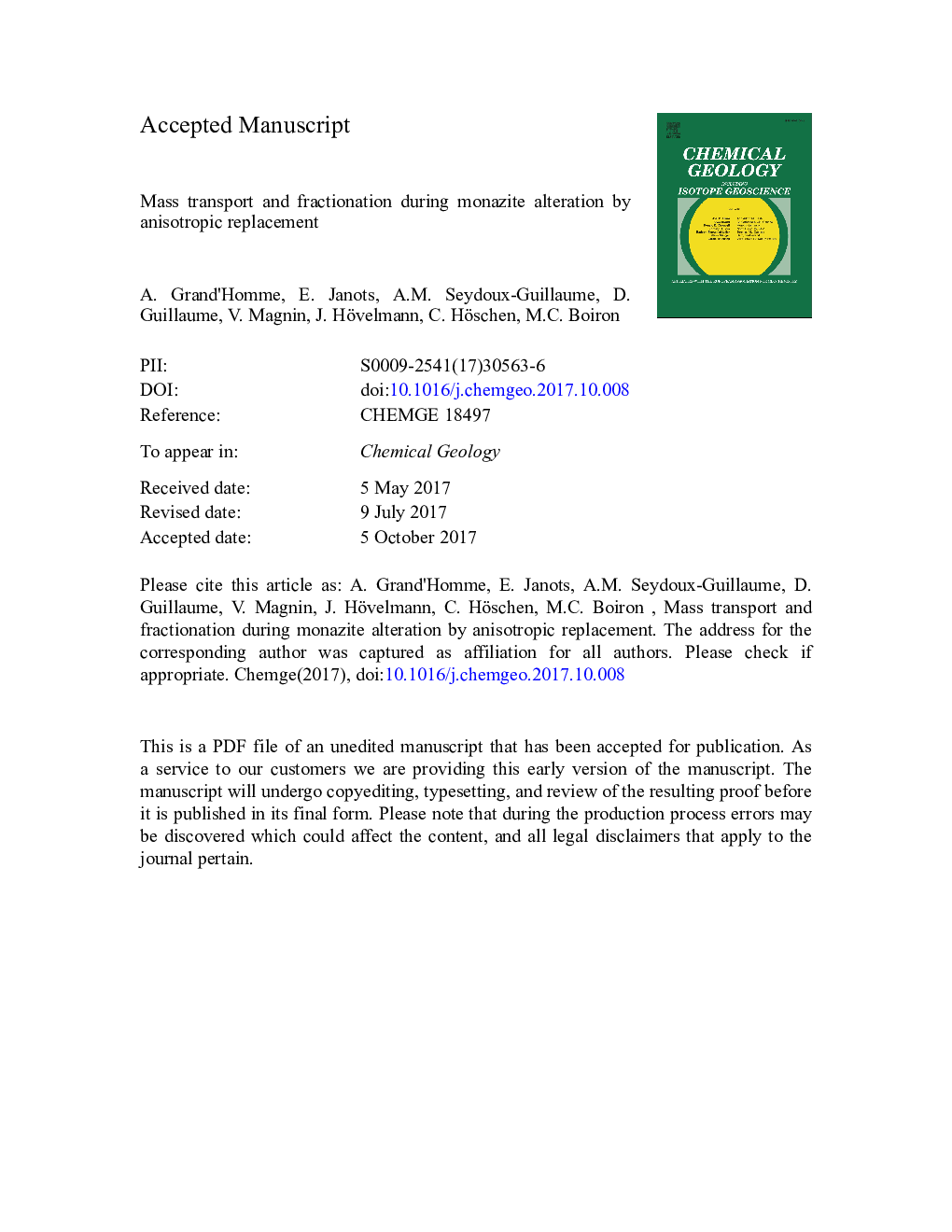| کد مقاله | کد نشریه | سال انتشار | مقاله انگلیسی | نسخه تمام متن |
|---|---|---|---|---|
| 8910250 | 1637490 | 2018 | 62 صفحه PDF | دانلود رایگان |
عنوان انگلیسی مقاله ISI
Mass transport and fractionation during monazite alteration by anisotropic replacement
ترجمه فارسی عنوان
حمل و نقل جرمی و تقسیم بندی در طی تغییرات مونازیت توسط جایگزینی آنی استروپیک
دانلود مقاله + سفارش ترجمه
دانلود مقاله ISI انگلیسی
رایگان برای ایرانیان
موضوعات مرتبط
مهندسی و علوم پایه
علوم زمین و سیارات
ژئوشیمی و پترولوژی
چکیده انگلیسی
The present experimental study investigates the causes of anisotropic replacement and its impact on the element mass transfer during monazite alteration by combining in situ characterization of solid and fluid products. Starting material of standard Manangotry monazite was placed at 200 MPa with 18O doped fluids, at temperature (T) between 300 and 600 °C, for durations between 14 and 114 days, in some cases with hematite-magnetite buffer, and in presence of pre-fractured quartz crystals. For all experiments with NaOH at T > 400 °C, monazite products show a replacement rim (altered domain), but with complex microstructures that are best explained by nanoscale observations. At 400 °C (and 500 °C), replacement propagates anisotropically through the unaltered domain, due to preferentially oriented dissolution and/or fracturing at the reaction interface. The altered domain corresponds to nanochannels of secondary monazite (Mnz2) intruding primary monazite (Mnz1), with nanopores filled by amorphous Si-rich inclusions at the reaction front (interface). At 600 °C, the altered domain increases in volume and becomes homogeneous and non-porous, due to textural (and chemical) reequilibration. However, nanoscale observations reveal an anisotropic propagation associated with dislocations and preservation of Mnz1 relics within the apparently homogeneous altered domain. Textural equilibration leads to transient pores/inclusions, which preferentially move toward the reaction front. In all experimental products, the abundant porosity attests to significant mass transfer during monazite replacement. Nanomixture within altered domains hampers accurate determination of Mnz2 composition, and is assumed to be responsible for the Pb measured in the rim, due to Mnz1 contribution. However, composition measurements indicate that Mnz2 contains higher light rare earth elements (LREE), higher Th/U ratio but lower Y, Th, U, Pb and Ca contents compared to Mnz1. Elements released in the fluid by monazite replacement are mobilized from the reaction front toward the grain boundary, and then redistributed between secondary Th-silicates and phosphates, Si-rich gel-like material and aqueous fluids. At T > 500 °C, analyses of inclusions trapped in replaced quartz confirm an efficient REE solubility in the alkaline solutions. The Si-rich gel-like inclusions contain high amounts of REE (e.g. 950-4600 ppm Ce), Th (4480-6170 ppm) and U (30-110 ppm), while aqueous fluid inclusions have high concentrations of REE and Th (around 100 s of ppm) compared to common natural brines. There is a fractionation of Th and U during Mnz1 replacement (Th/U ~ 70) with low Th/U ratios in the aqueous fluid (7-23) compared to the secondary solid products (up to 150), independently of the initial presence of hematite-magnetite buffer. This accounts for a fractionation within the isotopic Th-Pb and U-Pb ages within the altered domain. In natural samples observed microscopically, the complex anisotropic geometry of the replacement can lead to a nanomixture within apparently homogeneous altered domains (with partial resetting of the U-Th-Pb geochronometer), and to misleading interpretations of secondary inclusions within apparently unaltered domain.
ناشر
Database: Elsevier - ScienceDirect (ساینس دایرکت)
Journal: Chemical Geology - Volume 484, 5 May 2018, Pages 51-68
Journal: Chemical Geology - Volume 484, 5 May 2018, Pages 51-68
نویسندگان
A. Grand'Homme, E. Janots, A.M. Seydoux-Guillaume, D. Guillaume, V. Magnin, J. Hövelmann, C. Höschen, M.C. Boiron,
